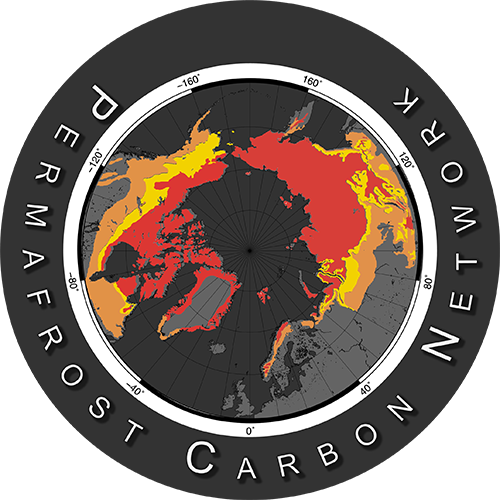Last update
EC_Tower: 2024-06-26
ATM_Tower: 2023-12-15
Chamber: 2024-11-25
Dissolved: 2024-06-26
Airborne: 2024-03-05
How to use this application
Map
The central element of this tool is the map, here all sites are shown.
- Site name
- Site ID
- Contact information
- Years with measurements
- Ecosystem
- Publication
Selection controls
On the right hand pane the site selection controls can be found
Table
The table at the bottom shows the metadata for each site, click the arrows to scroll down the list.
About this application
This tool maps the locations of current and historic study sites for greenhouse gas measurements from various observational platforms across the Arctic and boreal biomes within the polar regions of the northern hemisphere. Aiming at comprehensive metadata coverage across species and platforms, the assimilated information comprises carbon dioxide (CO2), methane (CH4) and nitrous oxide (N2O) measurements across five observational platforms: (1) eddy covariance towers and (2) flux chambers, both operated on terrestrial or aquatic ecosystems, aiming at resolving processes at local to landscape scales; (3) atmospheric towers and (4) airborne measurements, providing atmospheric observations that represent processes at regional to pan-Arctic scales, and (5) dissolved gas concentrations monitoring information that is mostly available for aquatic sites.
The database consolidates basic information about location of the sites and their characteristics, measurement period, contact information, and links to scientific publications, published datasets, and repositories. The presented metadata were gathered from community surveys conducted e.g. within the context of the EU-funded INTAROS project and the ERC-synergy project Q-Arctic, extraction of information from existing databases, and literature syntheses. This mapping tool presents the results of coordinated independent efforts that were united in a workshop titled ‘Reconciling historical and contemporary trends in terrestrial carbon exchange of the northern permafrost-zone’, funded by the Arctic Data Center and supported by the Permafrost Carbon Network.
Basic characteristics
- Study domain: This database comprises sites within the borders of the Arctic polar region, which primarily encompasses the Arctic biome and those parts of the boreal biome that are characterised by cryosphere elements such as permafrost and persistent winter season snow cover. The delineation of the domain has been defined somewhat flexible on purpose, allowing to include also sites further south and outside of this core domain due to their importance for overcoming data gaps for specific regions and/or biome types.
- Land cover: We distinguish the ecosystem type represented by a study site between barren, cropland, forest, grassland, lake, ocean, reservoir, river, shrubland, tundra, urban, and wetland based on available information (from publications or input from site operators and researchers). The lake category includes ponds and puddles, while the river category includes streams, ditches and canals. Where multiple ecosystem types apply to a site, we list all of them.
- Timeframe: Datasets obtained at a specific location or area of interest studied between 1970 and 2024 were considered for this analysis.
- Seasonality: To categorize study periods, we distinguish seasons when measurements were conducted between summer as the period of the growing season (May-October) and winter as the snow- and ice-covered season (November-April). This definition does not necessarily align with the seasonal patterns of the different sites, but is used here for simplicity to differentiate between field visits taking place at different times of the year.
- Gas species: The greenhouse gases CO2, CH4, and N2O were considered.
- Types of measurements: Greenhouse gas measurements in this context include the assessment of atmospheric mole fractions, as well as vertical ecosystem-atmosphere, soil-atmosphere, or water-atmosphere fluxes, and concentration measurements of greenhouse gases dissolved in water.
Scientific background
The Arctic region is experiencing rapid warming, with temperatures rising nearly four times faster than the global average. This accelerated warming has profound implications for the Earth's climate system, as the Arctic plays a critical role in regulating global climate dynamics. Of particular concern is the thawing of permafrost, perennially frozen soils, which are estimated to contain carbon stocks of at least 1,700 Pg. This enormous carbon reservoir is at risk of being partially released into the atmosphere upon thaw, triggering an accelerating feedback loop that would further amplify global warming. Simultaneously, ongoing warming within the high northern latitudes holds the potential to trigger substantial changes to permafrost ecosystem characteristics, including climate-induced vegetation changes that may lead to shrubification, or changes in hydrology that alter greenhouse gas flux patterns.
Quantifying the current Arctic carbon budget requires a comprehensive monitoring network across the Arctic. Furthermore, to facilitate accurate projections of its future evolution based on understanding the mechanisms that control carbon cycle dynamics, more in-situ data need to be integrated into process-based models. With Arctic landscapes being highly heterogeneous across spatial scales, a large number of observation sites would be needed to resolve the pronounced variability in greenhouse gas processes. However, the vast size of the Arctic region, in combination with logistical challenges linked to harsh climate conditions and scarce infrastructure, to date has permitted the establishment of only sparse observational networks. This leads to data gaps and limited spatial and temporal data coverage, for example in Siberia, parts of Canada and in mountainous regions. Therefore, an inventory of research sites can aid in the identification of those gaps and provide guidance where new sites should be established.
Suggested usage
This database is intended to support users in identifying the availability of observational data on greenhouse gases across different regions within the high northern latitudes, in order to address various questions related to high northern research sites. This service thus should make it easier to find out where and what greenhouse gas observations have been conducted, in which years and by whom, and where the collected data can be accessed.
Request for support
We very much hope you'll find this tool useful. If you do, please share it with interested colleagues, and help us to maintain and extend the underlying database:
- Metadata correctness: if you find missing and/or incorrect information for some of the sites listed, please let us know which updates and/or corrections are required.
- Data gaps: If you are aware of additional sites that are not yet listed, but should be included, please tell us about them.
How to cite
- Metadata overview:
Vogt, J., Pallandt, M. M. T. A., Basso, L. S., Bolek, A., Ivanova, K., Schlutow, M., Celis, G., Kuhn, M., Mauritz, M., Schuur, E. A. G., Arndt, K., Virkkala, A.-M., Wargowsky, I., and Göckede, M. (under review): ARGO: ARctic greenhouse Gas Observation metadata version 1, Earth Syst. Sci. Data Discuss. [preprint] - ABCflux database:
Virkkala et al., ESSD (2022): The ABCflux database: Arctic–boreal CO2 flux observations and ancillary information aggregated to monthly time steps across terrestrial ecosystems. - Eddy-covariance data subset:
Pallandt et al., Biogeosciences (2022): Representativeness assessment of the pan-Arctic eddy covariance site network and optimized future enhancements.
Pallandt et al., JGR-Atmospheres (2024): High-latitude eddy covariance temporal network design and optimization. - Flux chamber data subset:
Virkkala et al., Prog. Phys. Geogr.: Earth & Environ (2018): The current state of CO2 flux chamber studies in the Arctic tundra: A review.
Correspondence to
Mathias Göckede (mgoeck@bgc-jena.mpg.de)Contributing authors (in alphabetical order by institute)
Luana Basso (MPI-BGC)
Abdullah Bolek (MPI-BGC)
Mathias Göckede (MPI-BGC)
Kseniia Ivanova (MPI-BGC)
Mark Schlutow (MPI-BGC)
Judith Vogt (MPI-BGC)
Martijn Pallandt (Stockholm Univ.)
Gerardo Celis (Univ. Arkansas)
Marguerite Mauritz (Univ. Texas El Paso)
McKenzie Kuhn (Univ. British Columbia)
Ted Schuur (Northern Arizona Univ.)
Kyle Arndt (Woodwell Climate Research Center)
Anna Virkkala (Woodwell Climate Research Center)
Isabel Wargowsky (Woodwell Climate Research Center)
 ARGO: ARctic greenhouse Gas Observation meta-database
ARGO: ARctic greenhouse Gas Observation meta-database



